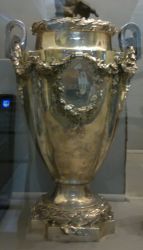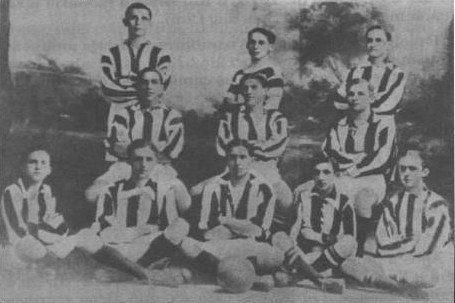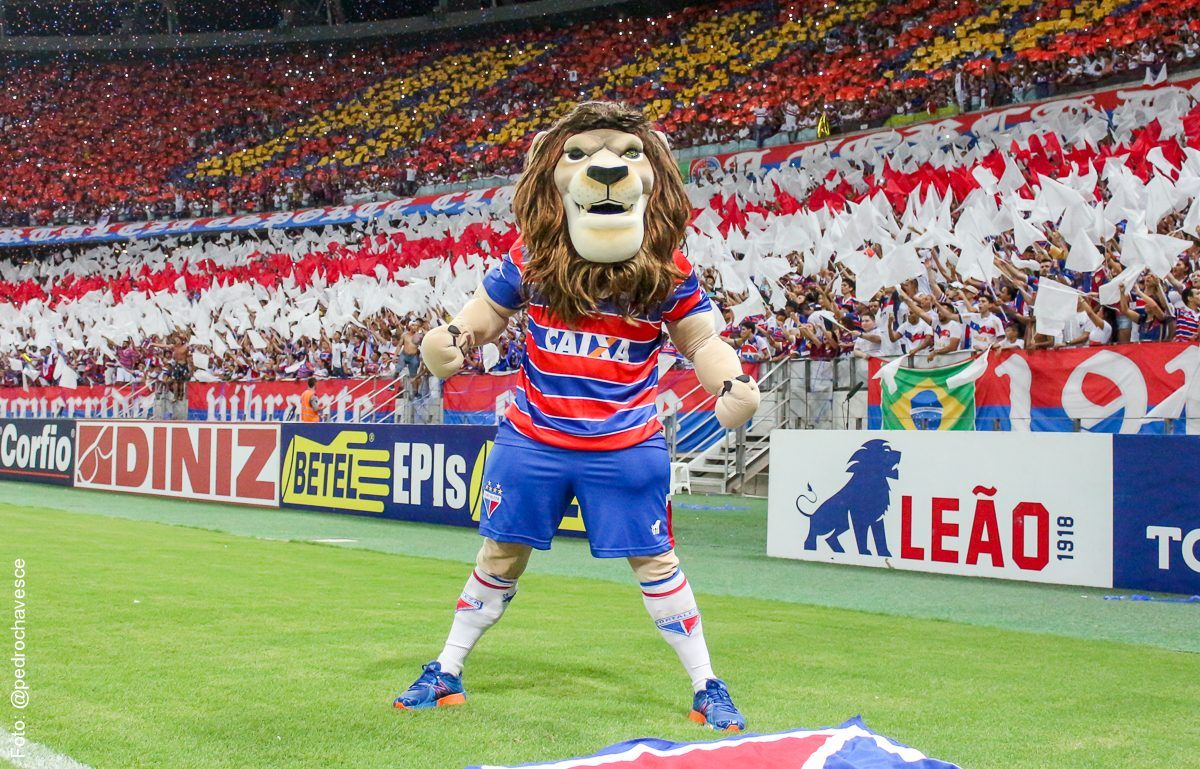|
1975 Campeonato Brasileiro Série A
The 1975 Campeonato Brasileiro Série A (officially the I Copa Brasil) was the 19th edition of the Campeonato Brasileiro Série A. Overview It was performed by 42 teams, and Internacional won the championship. It was divided into four phases: *In the First phase, the 42 teams were divided into two groups of eleven teams and two groups of ten. The teams played once against the teams of the other group that had an equal number of team to theirs, meaning that the teams of Group A would face the teams of Group B and the teams of Group C would face the ones of Group D. No teams were eliminated, and victories by two goals of difference or more were worth three points. *In the Second phase, the teams were divided into six groups. Two group comprised ten teams, with Group 1 receiving the top five teams in Group A and B, and Group 2 receiving the top five teams in groups C and D. The teams of those group played once against those of the other, and the six best teams in each group qualified ... [...More Info...] [...Related Items...] OR: [Wikipedia] [Google] [Baidu] |
Campeonato Brasileiro Série A
The Campeonato Brasileiro Série A (; English: "Brazilian Championship A Series"), commonly referred to as the Brasileirão (; English: "Big Brazilian"), and also known as Brasileirão Assaí due to sponsorship with Assaí Atacadista, is a Brazilian professional league for men's football clubs. At the top of the Brazilian football league system, it is the country's primary football competition. Contested by 20 clubs, it operates on a system of promotion and relegation with the Campeonato Brasileiro Série B. In 2021 the competition was chosen by the IFFHS as the strongest national league in South America as well as the strongest in the world. Due to historical peculiarities and the large geographical size of the country, Brazil has a relatively short history of nationwide football competitions. Only in 1959, with the advancements in civil aviation and air transport and the need to appoint a Brazilian representative to the first edition of the Copa Libertadores was a nationw ... [...More Info...] [...Related Items...] OR: [Wikipedia] [Google] [Baidu] |
Esporte Clube Bahia
Esporte Clube Bahia (), known familiarly as Bahia, is a Brazilian professional football club, based in Salvador, capital city of the Brazilian state of Bahia. They play in the Campeonato Baiano, Bahia's state league, and the Campeonato Brasileiro Série B, Brazil's second tier league. Bahia has won the ''Brasileirão'' title twice: in the 1959 season, defeating the Santos' ''Santásticos'' which contained figures such as Gilmar, Mauro, Mengálvio, Coutinho, Pepe and Pelé, in the finals and in the 1988 season Bahia edged Internacional. Bahia has only appeared in the Copa Libertadores three times, reaching the quarterfinals in 1989, Bahia's best-ever performance. The club has also won their state title a record 49 times. The 2000s have seen the club win only four state titles. Bahia was demoted to the ''Série B'' in 2003 and demoted, for the first time ever, to the Série C in 2005, spending two seasons at the bottom of the Brazilian league system. In 2007, they we ... [...More Info...] [...Related Items...] OR: [Wikipedia] [Google] [Baidu] |
Ceará Sporting Club
Ceará Sporting Club, or Ceará, as they are usually called, is a Brazilian football team from the city of Fortaleza, capital city of the Brazilian state of Ceará, founded on June 2, 1914, by Luís Esteves and Pedro Freire. Ceará is one of the most traditionally successful clubs in the Northeast region of Brazil alongside Bahia, Santa Cruz, Sport, Náutico, Vitória and their city rivals Fortaleza. History On June 2, 1914, the club was founded as Rio Branco Football Club by Luiz Esteves Junior and Pedro Freire. Later, some of their friends also joined: Gilberto Gurgel, Walter Barroso, Raimundo Justa, Newton Rôla, Bolívar Purcell, Aluísio Mamede, Orlando Olsen, José Elias Romcy, Isaías Façanha de Andrade, Raimundo Padilha, Rolando Emílio, Meton Alencar Pinto, Gotardo Morais, Artur de Albuquerque, Cincinato Costa, Carlos Calmon and Eurico Medeiros. As Rio Branco Football Club, the team colors were white and lilac. In 1915, on their first birthday, the club changed i ... [...More Info...] [...Related Items...] OR: [Wikipedia] [Google] [Baidu] |
Sociedade Esportiva Tiradentes
Sociedade Esportiva Tiradentes, commonly known as Tiradentes, are a Brazilian football team from Teresina. They won the Campeonato Piauiense five times and competed in the Série A five times. The women's team competed twice in the Copa do Brasil de Futebol Feminino. History Men's team They were founded on June 30, 1959. Tiradentes won the Campeonato Piauiense for the first time in 1972. They competed in the Série A in 1973, 1974, 1975, 1979 and in 1983. The club suffered Série A's largest goal margin in 1983, when Corinthians beat them 10–1. Women's team The club reached the second stage of the Copa do Brasil de Futebol Feminino in 2007, when they finished in Group 2's third place. Tiradentes reached the second stage in 2008, when they were eliminated by Sport. Stadium They play their home games at the Lindolfinho stadium. The stadium has a maximum capacity of 8,000 people. Achievements * Campeonato Piauiense: ** Winners (5): 1972, 1974, 1975( 1), 1982, 1990 ( ... [...More Info...] [...Related Items...] OR: [Wikipedia] [Google] [Baidu] |
Guarani Futebol Clube
Guarani Futebol Clube, colloquially called Guarani, is a Brazilian association football club in Campinas, São Paulo. Guarani is the only club from Brazil's countryside to have won the top tier of the Brazilian Championship. The team currently play in the Série B, the second tier of Brazilian football, as well as in the Campeonato Paulista Série A1, the top tier of the São Paulo state football league. It is also known as Bugre, a popular term for an Indigenous Brazilian, and its supporters are known as ''bugrinos''. History Guarani Football Club was founded on April 1, 1911, in the city of Campinas, São Paulo, as Guarany Foot-Ball Club, by the initiative of 12 students from the Gymnasio do Estado (now Culto à Ciência). The students, including Pompeo de Vito, Hernani Felippo Matallo and Vicente Matallo, usually played football at Praça Carlos Gomes. Vicente Matallo became Guarani's first president. Guarani was named after maestro Antônio Carlos Gomes' opera "Il ... [...More Info...] [...Related Items...] OR: [Wikipedia] [Google] [Baidu] |
Sport Club Corinthians Paulista
Sport Club Corinthians Paulista () is a Brazilian sports club based in the Tatuapé district of São Paulo. Although competing in a number of different sports, Corinthians is mostly known for its professional association football team that plays in the Campeonato Brasileiro Série A, the top tier of the Brazilian football, as well as in the Campeonato Paulista Série A1, the first division of the traditional in-state competition. Founded in 1910 by five railway workers inspired by the London-based Corinthian Football Club, Corinthians has become one of the most successful Brazilian clubs, having won the national title seven times, in addition to three Copa do Brasil trophies, one Supercopa do Brasil and a record 30 São Paulo State championships. On the international stage, the club won the inaugural FIFA Club World Championship in 2000, winning it for the second time in 2012 after being crowned Copa Libertadores de América champions for the first time that same year. The ... [...More Info...] [...Related Items...] OR: [Wikipedia] [Google] [Baidu] |
Atlético Rio Negro Clube
Atlético Rio Negro Clube, usually known simply as Rio Negro is a traditional Brazilian football club from Manaus, Amazonas state. Rio Negro is the second oldest club of Amazonas state, and is eleven months younger than its rival, Nacional.''Especial Placar – 500 Times do Brasil'', São Paulo: Editora Abril: 2003. Atlético Rio Negro Clube of Roraima state is named after the club, and shares the same logo, colors and kits. History On November 13, 1913, 14-year-old Shinda Uchôa and his friends founded Atlético Rio Negro Clube at Manuel Afonso do Nascimento (who was one of the founders) home. The club was named after the Negro River. Rio Negro's first president was Edgar Lobão. Shinda Uchôa was nominated president of honor. In 1921, Rio Negro won its first title, the state championship. In 1973, the club competed in the Campeonato Brasileiro Série A for the first time, finishing in the 30th position. In the following year, in 1974, Rio Negro finished in Campeonato ... [...More Info...] [...Related Items...] OR: [Wikipedia] [Google] [Baidu] |
Esporte Clube Comercial (MS)
Esporte Clube Comercial, usually known simply as Comercial, is a traditional Brazilian football club from Campo Grande, Mato Grosso do Sul state. The club competed several times in the Campeonato Brasileiro Série A. Comercial is currently ranked seventh among Mato Grosso do Sul teams in CBF's national club ranking, at 222nd place overall. History On March 15, 1943,Esporte Clube Comercial at Arquivo de Clubes Esporte Clube Comercial was founded by Etheócles Ferreira and other Colégio Dom Bosco (''Dom Bosco School'') students, who were sons of rich farmers and tradesmen. ''Enciclopédia do Futebol Brasileiro'', Volume 1 - Lance, Rio de Janeiro: Aretê Editorial S/A, 2001. In 1948, Jamil Naglis was elected as the club's president. He changed the club's colors to the c ... [...More Info...] [...Related Items...] OR: [Wikipedia] [Google] [Baidu] |
Botafogo De Futebol E Regatas
Botafogo (local/standard alternative Brazilian Portuguese pronunciation: ) is a beachfront neighborhood ('' bairro'') in Rio de Janeiro, Brazil. It is a mostly upper middle class and small commerce community, and is located between the hills of Mundo Novo, Dona Marta (which separates it from Laranjeiras) and São João (which separates it from Copacabana). The word Botafogo also refers to a Latin American ballroom dance move, named so because the area of Botafogo is where it originated. Etymology Botafogo was named after João Pereira de Sousa Botafogo (1540–1627), who was responsible for the galleon ''Botafogo'''s artillery. Because of that, he received the nickname "Botafogo" and included it in his family name. When he went to live in Brazil, the Portuguese Crown granted him the land known today as Botafogo. The name literally means "set it on fire" in Portuguese (a reference to the ''Botafogo'' galleon's artillery power). In the mid-19th century, English language spea ... [...More Info...] [...Related Items...] OR: [Wikipedia] [Google] [Baidu] |
Fortaleza Esporte Clube
Fortaleza Esporte Clube, usually known as Fortaleza, is primarily a football club, but is active in other sports such as futsal, handball and basketball. Fortaleza Esporte Clube is based in Fortaleza, capital of the State of Ceará, Brazil. The club was founded on October 18, 1918. Fortaleza is one of the most traditional clubs in the Northeastern region of Brazil alongside Bahia, Vitória, Santa Cruz, Sport, Náutico and Ceará, its biggest rival. The club's colors are red, blue and white. History On 23 February 1912, Alcides Santos founded a club called Fortaleza, and participated shortly after in the founding of the Stella Foot-Ball Club. Finally on 18 October 1918 Fortaleza Sporting Club is born, first denomination of the Fortaleza Esporte Clube. Its colors represent the colors of the French flag, since the founder spent time in France and decided to put the colors of the European country in the Brazilian club. In 1920, they participated in the foundation of the ... [...More Info...] [...Related Items...] OR: [Wikipedia] [Google] [Baidu] |
Sociedade Esportiva Palmeiras
Sociedade Esportiva Palmeiras (), commonly known as Palmeiras, is a Brazilian professional football club based in the city of São Paulo, in the district of Perdizes. Palmeiras is one of the most popular clubs in South America, with around 18 million supporters and more than 80,000 affiliated fans. Despite being primarily a football club, Palmeiras competes in a number of different sports. The football team plays in the Campeonato Paulista, the state of São Paulo's premier state league, as well as in the Brasileirão Série A, the top tier of the Brazilian football league system. Palmeiras was founded by Italian immigrants in 1914, as "Palestra Itália" (). However, the club changed its name on 14 September 1942, as a result of Brazil joining the Allies in the Second World War against Italy ("Itália" in Portuguese) and the Axis powers. Since then, Palmeiras has won 15 top-tier national competitions, including a record 11 Campeonato Brasileiro Série A, 4 Copas do Brasil ... [...More Info...] [...Related Items...] OR: [Wikipedia] [Google] [Baidu] |
Clube Do Remo
Clube do Remo, commonly referred to as Remo, is a Brazilian professional club based in Belém, Pará founded on 5 February 1905. It competes in the Campeonato Brasileiro Série C, the third tier of Brazilian football league system, Brazilian football, as well as in the Campeonato Paraense, the top flight of the Pará State football leagues in Brazil, state football league. Remo is the second-best ranked team from Pará in Brazilian Football Confederation, CBF's national club ranking, at 42nd overall. History Clube do Remo was founded on 5 February 1905, as Grupo do Remo. The founders, before founding Remo, had abandoned Sport Club do Pará. On 14 February 1908, Remo was closed, after the club's general assembly. On 29 March 1908, Remo's partners and Sport Club do Pará made a deal, and Remo was officially extinct in 1908. On 15 August 1911, Remo was reorganized following the initiative of Antonico Silva, Cândido Jucá, Carl Schumann, Elzaman Magalhães, Geraldo Motta, Jayme Li ... [...More Info...] [...Related Items...] OR: [Wikipedia] [Google] [Baidu] |



